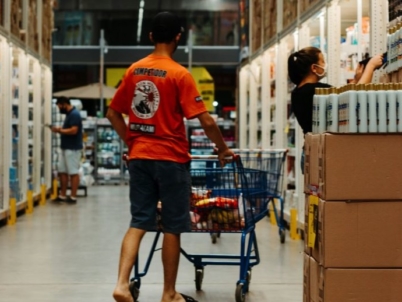-
AI startup Onton raises $7.5M to reinvent the way the world discovers and decides what to buy - November 26, 2025
-
Forklift Market Positions for Recovery as Confidence Expected to Build from 2026 - November 26, 2025
-
PROCare achieves 300% order capacity increase and 99% picking accuracy with Forterro’s ERP solution, Orderwise - November 26, 2025
-
DHL boosts operational efficiency and customer communications with HappyRobot’s AI Agents - November 25, 2025
-
STENA LINE TEAMS UP WITH CAMERA TELEMATICS TO DRIVE SAFETY IMPROVEMENTS AT IRISH SEA PORTS - November 25, 2025
-
Another design award for Toyota’s lithium-ion Traigo_i counterbalanced forklift - November 21, 2025
-
Stuut Technologies Raises $29.5 Million Series A Led by Andreessen Horowitz to Automate Accounts Receivable Work - November 20, 2025
-
INCREASED DIGITAL INVESTMENT REQUIRED TO KEEP PACE WITH 2026 CUSTOMS CHANGES - November 19, 2025
-
FULFILMENT SOLUTIONS FOR SPORTS MERCHANDISE: KEEPING OUR EYE ON THE GAME - November 19, 2025
-
COMPLEX, COSTLY & CONFUSING – THE END OF DE MINIMIS - November 19, 2025
By Tim Wright, Managing Director of Invar Systems
Chancellor Rishi Sunak’s Budget announcement of a capital allowance ‘super-deduction’ could be a game-changer for many warehouse owners and operators.
The super-deduction, which will apply for two years, allows firms to claim 130% of their expenditure on approved plant and machinery against their tax liability. There is no list of qualifying expenditure, but just about any equipment that one might install in a warehouse or distribution centre appears to be covered and, importantly, ancillary expenditure such as building alterations and electrical system upgrades to allow equipment installation are specifically included.

The Chancellor’s aim, beyond kick-starting the post-Covid recovery, is to address the UK’s chronic underperformance in productivity growth, which was less than stellar even before the 2008/9 financial crisis (2.3% per annum), and since then has essentially flatlined at 0.4% per annum. Discussing the validity and meaning of productivity data notoriously starts heated discussions amongst economists but in the warehousing sector the issues are very real and quantifiable.
The gorilla in the room is of course the inexorable rise of e-commerce, currently representing 30% or more of trade in many retail sectors, and with similar expectations for on-demand fulfilment of orders increasingly seen in business and industrial purchasing. Clearly, fulfilling two dozen orders for individual items is immensely more laborious than serving the same volume by shipping whole cases or pallets – by a factor of 15 according to one US study – inevitably driving down productivity per hour worked.
E-commerce has also driven up product variety, and, critically, the volume of returns to be handled. Yet this comes at a time when securing and deploying warehouse staff is becoming increasingly problematic: many businesses have been heavily dependent upon European labour, which is unlikely to be earning enough to qualify to work in the UK post-Brexit, while creating Covid-safe working in labour-intensive areas is a major challenge. Along with rises in the minimum wage, this is pushing labour rates up.
In addition, increasing capacity by adding more space is not an easy option – e-commerce operators, and businesses hedging against supply chain disruption are snapping up all the available space in what is generally agreed to be an ‘under-warehoused’ country.
These challenges, although increasing, are not new and nor is the obvious solution – automation. But apart from the ‘marquee brands’ such as Amazon and Ocado, who have been able to invest large sums in green-field developments, the warehousing sector has been slow to adopt automation, and where it has, the tendency has been to create unintegrated ‘islands of automation’ at particular pain points.
However, for real productivity improvement a warehouse or fulfilment centre needs to address all its many interdependent activities simultaneously: KPIs in receiving, in put-away, in picking, in packing, labelling and dispatch, as well as, in health and safety.
Importantly, this means a complete rethink of how the warehouse operates. A particular focus will be a move towards ‘goods-to-person’ operations, rather than having people spending most of their time walking unproductively between locations.
It’s easy to understand why many businesses have been reluctant to commit to change. Until quite recently, warehouse automation was ‘hard engineering’ – it involved not only major investment all in one go, but installation caused disruption, even complete shutdown, and was considered inflexible. Any change in requirements could only be accommodated by further significant investment and upheaval.
Happily, these constraints no longer apply. The development of autonomous mobile robots (AMRs) in particular has been a game changer, as has been the creation of easily reconfigurable sortation systems, re-locatable or even fully mobile pick faces, smart automated packing stations, and a raft of supporting technologies such as pick-to-light, along with Warehouse Management Systems that are becoming ever more capable, yet easier to adapt and use.
Such solutions are scalable and can be introduced flexibly, as funds allow. What’s more, they can be readily reconfigured to integrate with subsequent investments, largely off-line through the software, rather than by disruptive re-engineering that requires shutdown. They are also genuinely scalable – in many cases, simply adding more AMRs to the system can accommodate future growth or extension.
Rishi Sunak’s ‘super-deduction’ capital allowance offers the logistics sector a golden opportunity to invest in performance enhancing automation, giving fulfilment operations the boost to productivity needed to cope with the surge in ecommerce orders. It’s an opportunity not to be missed.
For more information on advanced warehouse automation go to www.invarsystems.com

































